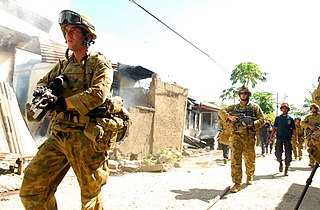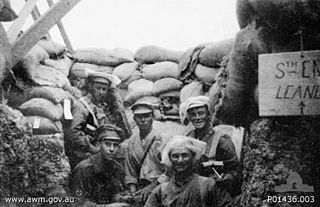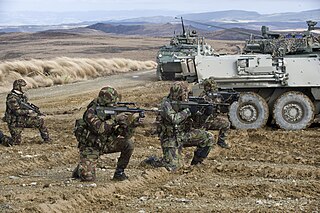
The First Australian Imperial Force was the main expeditionary force of the Australian Army during World War I. It was formed on 15 August 1914, following Britain's declaration of war on Germany, initially with a strength of one infantry division and one light horse brigade. The infantry division subsequently fought at Gallipoli between April and December 1915, being reinforced by a second division which was later raised, as well as three light horse brigades. After being evacuated to Egypt the AIF was expanded to five infantry divisions, which were committed to the fighting in France and Belgium along the Western Front in March 1916. A sixth infantry division was partially raised in 1917 in the United Kingdom, but was broken up and used as reinforcements following heavy casualties on the Western Front. Meanwhile, two mounted divisions remained in the Middle East to fight against Turkish forces in the Sinai and Palestine.
The Australian Mounted Division originally formed as the Imperial Mounted Division in January 1917, was a mounted infantry, light horse and yeomanry division. The division was formed in Egypt, and along with the Anzac Mounted Division formed part of Desert Column, Egyptian Expeditionary Force in World War I. The division was originally made up of the Australian 3rd Light Horse Brigade, the reconstituted 4th Light Horse Brigade, and two British yeomanry brigades; the 5th Mounted Brigade and 6th Mounted Brigade.

The New Zealand Expeditionary Force (NZEF) was the title of the military forces sent from New Zealand to fight alongside other British Empire and Dominion troops during World War I (1914–1918) and World War II (1939–1945). Ultimately, the NZEF of World War I became known as the First New Zealand Expeditionary Force. The NZEF of World War II was known as the Second New Zealand Expeditionary Force (2NZEF).

The Australian and New Zealand Army Corps (ANZAC) was a First World War army corps of the Mediterranean Expeditionary Force. It was formed in Egypt in December 1914, and operated during the Gallipoli campaign. General William Birdwood commanded the corps, which primarily consisted troops from the First Australian Imperial Force and 1st New Zealand Expeditionary Force, although there were also British and Indian units attached at times throughout the campaign. The corps disbanded in 1916, following the Allied evacuation of the Gallipoli peninsula and the formation of I ANZAC Corps and II ANZAC Corps. The corps was reestablished, briefly, in the Second World War during the Battle of Greece in 1941.
The 3rd Battalion, Auckland and Northland Regiment is a Territorial Force Battalion of the New Zealand Army, with Headquarters in Arch Hill Auckland Army Centre. The unit consists of Company sized units which have their headquarters in Auckland and Whangarei. The unit is part of Training and Doctrine Command (TRADOC) headquartered at Waiouru.

This article describes the current structure of the Australian Army. It includes the army's order of battle and the headquarters locations of major units. Members of the Australian Army also serve within joint units of the Australian Defence Force which fall outside the direct command of the Australian Army.

The 9th Battalion, Royal Queensland Regiment is a Reserve light infantry battalion of the Australian Army, raised and based in the state of Queensland. It is part of the Royal Queensland Regiment and is currently attached to the 11th Brigade of the 2nd Division. 9 RQR can trace its history as far back as 1867 with the establishment Queensland Volunteer Rifle Corps, although it was not until 1911 that it was designated as the "9th Battalion". Over the course of its history, the battalion has served Australia in a number of conflicts including The Boer War, World War I and World War II, while more recently, members of the battalion have been involved in various peacekeeping operations and exercises around the Pacific region.

The Egyptian Expeditionary Force (EEF) was a British Empire military formation, formed on 10 March 1916 under the command of General Archibald Murray from the Mediterranean Expeditionary Force and the Force in Egypt (1914–15), at the beginning of the Sinai and Palestine Campaign of the First World War.

The 3rd Brigade is a combined arms brigade of the Australian Army, principally made up of the 1st and 3rd Battalions of the Royal Australian Regiment. Initially raised in 1903 as part of the post-Federation Australian Army, it was removed from the order of battle in 1906 following the restructure of the field force. It was re-formed in 1914 for service during World War I, taking part in the fighting at Gallipoli and on the Western Front in Europe. During World War II the brigade was used in a defensive role before it was disbanded in 1944. It was re-raised in 1967 for service during the Vietnam War and later went on to provide the nucleus of the deployment to East Timor during the Australian-led intervention in 1999. The brigade is currently based at Lavarack Barracks in Townsville, Queensland.

Unit Colour Patches identify the wearer as belonging to a military formation or unit.

Colchester Garrison is a major garrison located in Colchester in the county of Essex, Eastern England. It has been an important military base since the Roman era. The first permanent military garrison in Colchester was established by Legio XX Valeria Victrix in AD 43 following the Roman conquest of Britain. Colchester was an important garrison town during the Napoleonic Wars and throughout the Victorian era. During the First World War several battalions of Kitchener's Army were trained there. Now, 2nd Battalion and 3rd Battalion of The Parachute Regiment are based there. Today there are new barracks, which, in replacing the Victorian buildings, have made available building land slightly nearer the town centre.

Operation Astute was an Australian-led military deployment to East Timor to quell unrest and return stability in the 2006 East Timor crisis. It was headed by Brigadier Bill Sowry, and commenced on 25 May 2006 under the command of Brigadier Michael Slater. The operation was established at the request of East Timor's government, and continued under an understanding reached between Australia, East Timor, and the United Nations, with the United Nations Integrated Mission in East Timor supporting and helping to develop East Timor's police force. Other countries deploying soldiers to East Timor include Malaysia, New Zealand and East Timor's former colonial power Portugal, operating under independent command.

The 3rd Battalion was an infantry battalion of the Australian Army. Originally raised as part of the First Australian Imperial Force for service during World War I, the battalion formed part of the 1st Brigade, attached to the 1st Division. It was formed shortly after the war broke out and was among the first Australian units to be sent overseas, arriving in Egypt in December 1914. In April 1915 the battalion participated in the Landing at Anzac Cove, coming ashore in the second and third waves. In December 1915 the 3rd Battalion was evacuated from the Gallipoli peninsula and withdrawn to Egypt again, where it took part in the defence of the Suez Canal before being sent to France to fight on the Western Front in March 1916. For the next two and a half years the unit would serve in the trenches in France and Belgium and would take part in many of the major battles fought during that time. In May 1919, following the end of the war, the battalion was disbanded and its personnel repatriated back to Australia.

The 12th Battalion was an infantry battalion originally raised for the First Australian Imperial Force during the First World War. The battalion was recruited from Tasmania, South Australia and Western Australia and formed part of the 3rd Brigade, 1st Division. It served throughout the war, firstly during the Gallipoli Campaign and then on the Western Front. During the interwar years, the 12th Battalion was re-raised as a part-time military unit and during the Second World War undertook garrison duties in Australia, but did not see combat. Today its lineage is perpetuated by the 12th/40th Battalion, Royal Tasmania Regiment, a unit which continues to serve in the Australian Army Reserve.

The 11th/28th Battalion, Royal Western Australia Regiment is a Reserve infantry battalion of the Australian Army. Located in Western Australia, it is one of the two battalions of the Royal Western Australia Regiment which forms the infantry component of the 13th Brigade.
Forces Command (FORCOMD) is the largest command within the Australian Army responsible for the combat brigades, the enabling and training formations reporting to the Chief of the Army with approximately 85% of the Army’s personnel. The Command was formed on 1 July 2009 with the amalgamation of Land Command and Training Command, and is led by a major general as the Commander Forces Command.
The 1st Brigade is currently the largest unit of the New Zealand Army, and contains most of the army's deployable units. The brigade was formed on 13 December 2011 by amalgamating the 2nd Land Force Group and 3rd Land Force Group. Its establishment formed part of the 'Army 2015' package of reforms.

This article describes the current structure of the New Zealand Army. It includes the army's order of battle and the headquarters locations of major units.

The Force in Egypt was a British Army formation established in August 1914 to administer garrisoning armed forces in Egypt at the beginning of the First World War. The force had the objective of protecting the Suez Canal and was originally commanded by Major General Julian Byng, but he was replaced by General J. Maxwell, who took command on 8 September 1914. Initially, the main threat to the Suez came from Germany and throughout the early months several of the force's elements were sent to Europe to take part in the fighting on the Western Front. On 5 November 1914, Britain and France declared war on the Ottoman Empire, after which the Force in Egypt faced a direct threat from Ottoman forces, which was realised in February 1915 with a raid on the Suez Canal. This threat remained until 1916 when the British forces went on the offensive.















